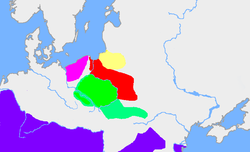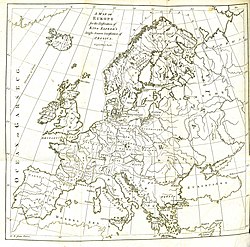Aesti

TheAesti(alsoAestii,AstuiorAests) were an ancient people first described by theRomanhistorianTacitusin his treatiseGermania(circa 98 AD).[1]According to Tacitus, the territory of Aesti was located somewhere east of theSuiones(Swedes).
Overview[edit]
According to Tacitus, the Aesti liveUpon the right of the Suevian Sea[2]and have the same customs and attire as the GermanicSuevi.It has been suggested that the Aesti worshipped the mother of the gods, similar to theNerthuscult amongnorthern Germanicpeoples.[3]Though they were most likely ofBalticorigin, they had extensively intermingled with the neighbouring Gothic Tribes.[4][5]
Tacitus wrote that the Aesti were "the only people who collect amber—glaesumis their own word for it—in the shallows or even on the beach ".[6]Glaesum,an apparently Latinised word foramber(in Latin,sucinum), is the only surviving example of the Aestian language. The word is quoted of being of Germanic origin, given its similarity to theGothicwordglas.[7]Tacitus, however, describes the language ofAestiias closer to that spoken in Britain than that spoken by other neighbouring tribes.[8]
TheOld Prussianand modernLithuaniannames for theVistula Lagoon,AīstinmariandAistmarės,respectively, appear to derive fromAestiandmari( "lagoon"or" fresh-water bay "), which suggests that the area around the lagoon had links with the Aesti.[9]
Historical sources[edit]
Tacitus[edit]


The ancient writers, beginning with Tacitus, who was the first Roman author to mention them in hisGermania,provide very little information on the Aestii.[10]Although Tacitus never travelled toMagna Germaniahimself and only recorded information he had obtained from others, the short ethnographic excursus below is the most detailed ancient account of the Aestii that we have:
"Upon the right of the Suevian Sea the Aestian nations reside, who use the same customs and attire with theSuevians;their language more resembles that of Britain. They worship the Mother of the Gods. As the characteristic of their national superstition, they wear the images ofwild boars.This alone serves them for arms, this is the safeguard of all, and by this every worshipper of the Goddess is secured even amidst his foes. Rare amongst them is the use of weapons of iron, but frequent that of clubs. In producing of grain and the other fruits of the earth, they labour with more assiduity and patience than is suitable to the usual laziness of Germans. Nay, they even search the deep, and of all the rest are the only people who gather amber. They call itglesum,and find it amongst the shallows and upon the very shore. But, according to the ordinary incuriosity and ignorance of Barbarians, they have neither learnt, nor do they inquire, what is its nature, or from what cause it is produced. In truth it lay long neglected amongst the other gross discharges of the sea; till from our luxury, it gained a name and value. To themselves it is of no use: they gather it rough, they expose it in pieces coarse and unpolished, and for it receive a price with wonder.
The placement of the Tacitean Aestii is based primarily on their association with amber, a popular luxury item during the life of Tacitus, with known sources at the southeastern coast of theBaltic Sea.The Balticamber trade,which appears to have extended to theMediterranean Sea,has been traced by archaeologists back to theNordic Bronze Age;its major center was in the region ofSambia.[citation needed]
This trade probably existed before the historicalTrojan Warin the 13th century BCE, as amber is one of the substances in which the palace ofMenelausatSpartawas said to be rich inHomer'sThe Iliad.[11]
Cassiodorus[edit]
Cassiodorus'Variae,published in 537, contains a letter written by Cassiodorus in the name ofTheodoric the Great,addressed to the Aesti:
It is gratifying to us to know that you have heard of our fame, and have sent ambassadors who have passed through so many strange nations to seek our friendship.
We have received the amber which you have sent us. You say that you gather this lightest of all substances from the shores of ocean, but how it comes thither you know not. But as an author named Cornelius (Tacitus) informs us, it is gathered in the innermost islands of the ocean, being formed originally of the juice of a tree (whence its name succinum), and gradually hardened by the heat of the sun. Thus it becomes an exuded metal, a transparent softness, sometimes blushing with the color of saffron, sometimes glowing with flame-like clearness. Then, gliding down to the margin of sea, and further purified by the rolling of the tides, it is at length transported to your shores to be cast upon them. We have thought it better to point this out to you, lest you should imagine thatyour supposed secrets have escaped our knowledge.We sent you some presents by our ambassadors, and shall be glad to receive further visits from you by theroad which you have thus opened up,and to show you future favors.
The style of the letter proves that the nation was at that time independent, not ruled by theOstrogoths.Apparently Cassiodorus considered it politically essential to establish friendly relations with the Nordic region. The letter also indicates that the Aesti were fully confident of the value of amber and had made out of it a trade secret. The sending of presents and the promise to show future favors were in ancient times a cordial way of givingde jurerecognition to another power.[12]
Jordanes[edit]

Sixth Century historianJordanesmakes two references to the Aesti in his book "The Origins and the Deeds of the Goths", which was a treatment of Cassiodorus' longer book (which no longer survives) on the history of the Goths. The first quote places the Aestii beyond the Vidivarii, on the shore of the Baltic: "a subject race, likewise hold the shore of Ocean." The next quote concerns the subjugation of the Aesti byHermanaric,king of the GothicGreuthungi:"This ruler also subdued by his wisdom and might the race of the Aesti, who dwell on the farthest shore of theGerman Ocean".
Alfred the Great[edit]

In an 11th-century manuscript ofKing Alfred's account of the voyage fromHedebytoTrusobyWulfstan,held by theBritish Museum,includes ethnographic information on the medieval Aestii,[13][14]in which the termsEsti,Est-mereandEastlandare used referring toOld Prussians.[citation needed]In the text, a summary description of the country and its riches is followed by a very detailed account of the people's funeral customs.[15] [16]It mentions the old trading portTrusoof Old Prussians and also calls the landWitland- "the Vistula is a very large river, and near it lie Witland andWeonodland;and Witland belongs to the Esthonians [ "belimpedh to Estum" ]. "[17]
Adam of Bremen[edit]
During the 11th centuryAdam of Bremen,citingEinhard(who in theVita Caroli Magnistates "the Slavs and the Aisti live on the shores of the Eastern Sea" ), mentions the coastal tribe as the Haisti, and refers to today's Estonia as Aestland.[18]
See also[edit]
Notes, citations and references[edit]
- ^Tacitus,Germania,Germania.XLV(wikisource)
- ^"Tacitus on Germany".gutenberg.org.
- ^Lang, Valter.The Bronze And Early Iron Ages In Estonia,Estonian Archaeology 3.University of Tartu Press, Tartu. 2007. Accessed 26 December 2013
- ^Bliujienė, Audronė (2010)."The Backcountry Balts (Aesti) and the 'Northern Gold' in Late Antiquity and the Early Middle Ages".Studies in the Early Middle Ages.32(1): 13–14.doi:10.1484/M.SEM-EB.3.5083.ISBN978-2-503-53125-0– viaBrepols.
- ^Kilian, Lothar (1962)."Review: Aestii, an Analysis of an Ancient European Civilization".Historische Zeitschrift.195(3): 637–640.JSTOR27613370– viaAkademie Verlag.
- ^Tacitus Germania.facultystaff.richmond.edu accessed 26 August 2018.
- ^Rübekeil, Ludwig.Suebica - Völkernamen und EthnosInnsbruck, 1992. p. 72f.
- ^Tacitus,Germania,Germania.XLV(wikisource)
- ^ Mikkels Klussis,Dictionary of Revived Prussian: Prussian - English, English - Prussian,Vilnius 2005–06, p. 47.
- ^For a theory that the Aestii are theOsismiiofStraboand the Ostimii ofPytheasalso mentioned by Strabo, seeBojtàr, Endre (1999).Foreword to the Past: a Cultural History of the Baltic People.Central European University Press. p. 104.ISBN963-9116-42-4.This is not a majority view as there is evidence of the continuity of theOsismiiin France.
- ^Lillian Feder(1964),Crowell's Handbook of Classical Literature,p. 192. US: Crowell.
- ^Edgar V. Saks.Aestii.p. 52–53.
- ^Kemp Malone,On King Alfred's Geographical Treatise,Speculum, Vol. 8, No. 1. (Jan., 1933), pp. 67-78
- ^Samuel H. Cross,Notes on King Alfred's North: Osti, Este,Speculum, Vol. 6, No. 2. (Apr., 1931), pp. 296-299
- ^dsmsw10.txtgutenberg.org
- ^Orosius, Paulus; Alfred, King of England (1859). Hampson, Robert Thomas (ed.).King Alfred's Anglo-Saxon version of the Compendious history of the world by Orosius.Translated by Bosworth, Joseph. p. 101 – via archive.org.
- ^King Alfred's Anglo-Saxon Version of The Compendious History of the World by Orosius,1859, p.22 & 51.
- ^Endre Bojtár,Foreword to the past: a cultural history of the Baltic people,Central European University Press, 1999, p106
Cited sources[edit]
- Deutschler, Yorck:"Die Aestii - Bezeichnung für die heutigen Esten Estlands oder die untergegangenen Pruzzen Ostpreußens",in: Deutschler, Yorck,"Die Singende Revolution" - Chronik der Estnischen Freiheitsbewegung (1987–1991),pp. 196–198. Ingelheim, March 1998/June 2000.ISBN3-88758-077-X
- Saks, Edgar Valter(1960).Aestii, An Analysis of an Ancient European Civilization. Studies in the Ur-European History ". Part 1.Montreal–Heidelberg:Võitleja.link
Further reading[edit]
- Beresnevičius, Gintaras. "Aisčiųmater deumklausimu ". In:Liaudies kultūra2006, Nr. 2, pp. 6–9.ISSN0236-0551https:// lituanistika.lt/content/4244
- (in Lithuanian) E. Jovaiša,Aisčiai. Kilmė(Aestii. The Origin). Lietuvos edukologijos universiteto leidykla, Vilnius; 2013.ISBN978-9955-20-779-5
- (in Lithuanian) E. Jovaiša,Aisčiai. Raida(Aestii. The Evolution). Lietuvos edukologijos universiteto leidykla, Vilnius; 2014.ISBN9789955209577
